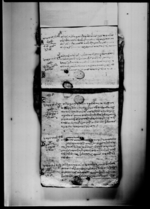A copy of a lālamohara from King Gīrvāṇayuddha appointing Lachīnātha
as priest of Śrī Ratannātha at Phalābāṅ (VS 1873)
ID: K_0013_0020B
Edited and
translated by Astrid Zotter and Christof Zotter
Created: 2018-07-26;
Last modified: 2018-11-14
For the metadata of the document, click here
Published by Heidelberg Academy of Sciences and Humanities: Documents on the History of
Religion and Law of Pre-modern Nepal, Heidelberg, Germany, 2018.
Published by the courtesy of the National Archives, Kathmandu. The copyright of
the facsimile remains with the Nepal Rashtriya Abhilekhalaya (National Archives,
Government of Nepal).
All use of the digital facsimiles requires prior written permission by the copyright holder. See
Terms of Use.
The accompanying edition, translation/synopsis and/or commentary are available under the terms of the
Creative Commons Attribution-ShareAlike 4.0 International License 
.
Abstract
In the original of which this document is a copy, Lachīnātha is appointed to perform
the regular and occasional worship of Ratannātha at Phalābāṅ.
Diplomatic edition
[1r]
1५८नं
2पो१३पा५१सी•३०७
3पुजारी
4भंनौ
हर्ष5हेनौ
राम1आगे
लछीनाथ•प्रतीफलावांगकाश्रीरतन्नाथकाथानकोनी
2त्यनैमीत्यपुजागरी•हाम्रोजयेमनाउनु•अघीदेषीरह्याकोगुठी
3दैदस्तुर
वुठीनाथलेषायाचेर्च्याकोतिमीलेपनीषानुभनीव
4क्स्यौषातीरज्मासंगश्रीरतन्नाथकापुजाटहलमारुजुरहीभो
5ग्यगरईतीसम्वत१८७३सालश्रावणवदी५रोज१शु
¯¯
[unknown seal]
[unknown seal]
[unknown seal]
Translation
[1r]
Number 581
Bundle (po[kā]) 13, pā 51,
sī 3072
[Concerning a] pūjārī3
Bhaṃ. nau.4 Harṣa
He. nau.Rāma
Āge: to Lachīnātha
We [herewith] grant [you the following rights]: to perform regular and occasional
worship at the shrine of Śrī Ratannātha at Phalābāṅ (text: Phalābāṃga), celebrate
our triumphs [and] enjoy the guṭhī and the customary fees (daidastura) that have existed from earlier times onwards and
were [hitherto] enjoyed and under the oversight of Buṭhīnātha. Be present for worship service of Śrī Ratannātha,
conscious of your duty, and enjoy [the attendant fruits].
Sunday, the 5th of the dark fortnight of the month of Śrāvaṇa, in the
[Vikrama] era year 1873 (1816 CE).5 Auspiciousness.6
Commentary
Among the documents that Yogī Naraharinātha found in the possession of rājaguruNārāyaṇanātha Yogī, a disciple in the tradition
(parampara) of Ratannātha's pūjarīPīraBrahmanātha Yogī, is an executive order (rukkā) issued a few years before the present document in VS 1869, Caitra
sudi 14 (Naraharinātha VS 2022: 449). This document
responds to a petition by pūjarīBuṭinātha and orders that throughout the whole ambala of Phalābāṅ the tenants (mohī),
householder (gharabārī) jogīs and others fill
the khaparapāthī7 for Ratannātha once a year. This "Buṭinātha" is
probably identical with the "Buṭhīnātha" of the present document and the "Buṭinnātha" who succeeded "Lachi[n]nātha" as pūjārī in VS 1877, Āṣādha vadi 6
(see K_0015_0012B). For its part, the "filling of the kaparapāthī"
may have been the annually paid daidastura, or at least have
formed part of it.
For more details on the cult of Ratannātha in Phalābaṅ and its close relation to the
royal court there, see Bouillier 1993: 33f., 35 and
passim.
Notes
1. This number refers to the place of the document in the
government ledger, whose entries were microfilmed sequentially by the NGMPP from K
13/1 (front cover and note) up to K 14/18 (index and back cover). According to a
note on the first page of the bound material archived as BK 8 (see catalogue entry
K_0013_0001) the "Hill Administration Department" sent these copies of
lālamoharas to the "Guṭhī" in VS 2001 (1944 CE). Due to the
low quality of the photographic reproduction of this note, this information,
gleaned from the NGMPP catalogue card, cannot be verified on the basis of the
original material. The assemblage covers the main body (i.e. excluding the initial
and final formalities) of 230 royal documents from the period VS 1868–1895 that
pertain to
guṭhī affairs.
[⇑] 2. While the first abbreviation,
po, probably stands for
pokā ("bundle")
it remains unclear what words the following
pā and
sī are abbreviations of. That these indeed are abbreviations
is clear from preceding entries, where the same syllables are followed by a
dot.
[⇑] 3. The documents seem to
have been given a variety of keywords for identification purposes during the
copying and archiving process. Other documents bear, for example, the word
guṭha in the corresponding place (NGMPP K 13/20E).
[⇑] 4. The abbreviation
nau. could stand for
nausindā. If so,
then this and the following line could state the names of the clerks involved in
copying documents or, more likely, in checking whether copies were true to
originals. That the post of
nausindā constituted the lowest
rank of clerks in offices would also explain why both persons are referred to by
their first names only. It may be speculated further that they were the pair one
of whom "said" (
bhaṃ[ne] nau[sindā]), i.e. read, the original
out loud, and the other of whom "watched" (
he[rne]
nau[sindā].), i.e. looked at and rechecked what was written. In
comparable assemblages of office copies, similar marginal notes turn up in the
context of approving that the copy was true to the original (see e.g.
K_0029_0025A,
K_0029_0025B).
[⇑] 5. The date corresponds to Sunday,
14 July 1816. Thus the reigning king in whose name the original
lālamohara must have been issued was still King
Gīrvāṇayuddha, who passed away on 20 November of that same
year.
[⇑] 6. The syllable
śu
abbreviating the standard
śubham is hardly legible in this
place and seamlessly blends into the horizontal stroke used to fill the rest of
the line.
[⇑] 7. Khapara (fr.
S.
kharpara, mod. Nep.
khaparu) denotes the
begging bowl of an ascetic. A
pāthī is a volumetric unit
"equivalent to 2.43 kg of paddy, 3.4 kg of wheat or maize, or 3.28 kg of millet"
(
M.C. Regmi 1999: 235; cf.
M.C.
Regmi 1978: 163).
[⇑]

